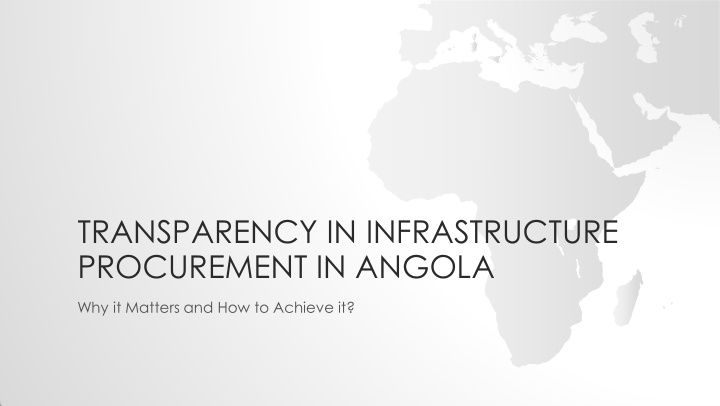



TRANSPARENCY IN INFRASTRUCTURE PROCUREMENT IN ANGOLA Why it Matters and How to Achieve it?
1. WHY IT MATTERS…
PUBLIC INVESTMENT INSTITUTIONS MATTER • IMF has identified 15 institutions that are of vital importance to strengthen efficiency of public investment management • #13: “ Transparency of budget execution that ensures that major investment projects are tendered in a competitive and transparent process , monitored during project implementation, and independently audited” • PIM priorities for low-income developing countries: “transparency of budget execution, openness of the procurement process , and efficiency of cash management are critical to the stability and predictability of investment and to reducing opportunities for rent seeking .” • http://www.imf.org/external/np/pp/eng/2015/061115.pdf
Public Investment Spending USD HUGE AMOUNTS bn (nominal) INVESTED $36.26 • Immense challenge reconstructing the $26.92 country after the civil war • Unparalleled resources to lift the task (PIP per capita 2013: $579) $4.24 • Bang for their buck? 2002-2005 2006-2009 2010-2013
ROAD REHABILITATION Until 2010 2011 2012 2013 2014 Total Primary 6,403 km 986 km 2,581 km 1,156 km 1,114 km 12,240 km Secondary - - 412 km 593 km 646 km 1,651 km Tertiary - - 539 km 776 km 703 km 2,018 km Bridges 286 8 5 7 32 338
Planned vs completed km of roads ROAD 2013 - 2014 REHABILITATION CONT. 2013 Road budget 2014: $1.2bn • Cost ? • If “on budget”: $1.1m per • kilometre 2014 0 500 1000 1500 2000 2500 3000 3500 4000 PND objective Achieved
ROAD QUALITY • 2011: • 58% of primary & secondary roads in ‘good’ condition • 40% of tertiary roads in ‘good’ condition • 2015 • No data publically available • Anecdotal evidence: general sense that quality is poor and that this is a major constraint for economic diversification
2. HOW TO ACHIEVE IT?
THE UGLY, THE BAD AND THE GOOD • The “ugly” sides of Angola are well known and documented • Highly centralized power in the Presidency • Extensive patronage networks • High perceived levels of rent-seeking and corruption • Corruption associated with higher levels of public investment • The bad news • Low levels of transparency overall • Legal framework for procurement has room for improvement • Unfortunately enforcement is very weak • What are the good news?
SOME INSTITUTIONAL STRENGTHENING • Procurement office changed to the National Procurement Service • Transparency, publication of procurement statistics • Oversight, including through compliance audits • Training of procurement staff • Debatable if this type of institutions can bring real change • Further institutional strengthening is the only way forward • The crisis creates very strong incentives to increase efficiency of public investments • Mid- to high-level management of public administration improving • Senior level political change is coming to Angola…
OBRIGADO!
Recommend
More recommend